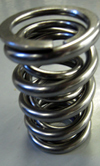Going lighter and stronger
 Esslinger Engineering of South El Monte, California, is primarily in the business of building midget engines based on Ford internals. The company has been in this line of work since 1990.
Esslinger Engineering of South El Monte, California, is primarily in the business of building midget engines based on Ford internals. The company has been in this line of work since 1990.
Because its engines are not based on pushrod designs, Dan Esslinger, president, says there are not very many valve-spring issues. "It's just the design of the engine and the design of the camshaft," he says. "Even though we turn a lot of rpms (in the neighborhood of 10,000), we are not cycling the kind of weight that a pushrod engine would, so the valve springs haven't been nearly the issue they have been for some other builders."
Esslinger uses an off-the-shelf Manley Performance Products tool-steel dual valve spring without inserted damper. "It's their polished spring - it almost looks like it's chromed. This valve spring takes a lot of stress out of the material and we have had excellent luck with them. It's nice and light too, about a third of the weight of other springs we've used," he says.
The heat-treated spring is part of the NexTek grouping of oval track endurance valve springs with a maximum valve lift of .750 in. It has an outside diameter of 1.580 in and an inside diameter of 0.812 in. With chrome silicon of premium grade, this particular valve spring is kept free of impurities, according to Manley Performance.
Esslinger admits, "Depending on the customer and how hard they run, usually, if a guy goes 20 races, we'll change out the valve springs. It just doesn't feel like the spring owes us anything at that point.
"Every spring is the same that way. There isn't a lot to them - it all depends on the harmonics - so we try to keep them out of the 'unhappy spot' to make them last longer."
The company does not use a Spintron to test its products; it has its own methods to determine the 'unhappy spot' for a valve spring. "We kind of chase problems. You have a problem, you move something around and find what it likes," Esslinger says. "Sometimes you can tell by adjusting something or by results as to what's going on. We're more results-based than anything."
Esslinger chose to use Manley valve springs as his standard for midget engines about three years ago, tending to that direction because of the spring's lighter weight. "Weight is always an issue, but we still need the strength for our compression (just over 15:1) and high rpm level. You come to find out there are very few spring manufacturers out there that can do the job we need."
Esslinger Engineering has been able to stay fairly stable with its camshaft design and the balance of its valvetrain items - since it started the midget programme it has used four camshaft designs. "That is a pretty low number. We've tried to stay away from those kinds of changes if we can avoid them," Esslinger says.
"We have just come out with a new camshaft and we're pretty happy with that. We got it at the end of last season and it was more a design to try and soften the loading. Because of the design of our engine, we can't just use anybody's cam design. It costs a pretty penny just to try one - and we've had pretty reasonable success with Brian Crower and Web Cams."
The camshaft stability and the new, lighter valve spring have helped Esslinger Engineering to become the dominant engine builder in the USAC National Midget championship. "We're not having any wear issues, and with our strength in numbers - at O'Reilly Raceway Park the Night Before the 500, there were 40 cars and we had 24-25 of them - those adjustments have been good for the company's overall success.
"This is to our advantage, not having to make big sweeping changes to find that golden BB (the magic spot). Whatever it is that's going to get you where you want to be, we're able to make small changes and therefore smaller mistakes."
Producing about three engines a week, Esslinger relies on the five sets of valve springs he keeps on the shelf in constant rotation. "We can get them next day if needed," he said.
Fig. 1 - Manley valve springs work for Esslinger Engineering, as they are both light and strong (Photo: Anne Proffit)
Written by Anne Proffit